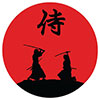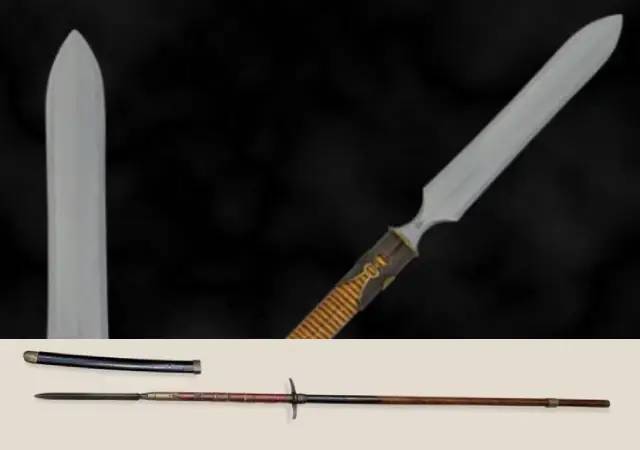
Yari is one of the traditional Japanese cold weapons (nihonto), which is a spear with a straight tip. The art of wielding a yari is known as sojutsu, a spear fighting technique.
History of Origins
The first yari are believed to have been derived from Chinese spears and were called hoko-yari. These early examples date back to the Nara period (710-794). Although the word yari did not appear in written records until 1334, it was not until the late 15th century that this type of weapon became widespread in Japan.
Initially, duels between bushi (samurai) were ritualized. They were duels in which warriors on horseback challenged each other by shooting an arrow at their opponent. However, after the attempted Mongol invasions of Japan in 1274 and 1281, the nature of Japanese warfare changed radically.
The Mongols used Chinese and Korean warriors armed with long pikes and fought in tight formations. Such units were effective against cavalry, and the Japanese had to adapt. As a result, wooden weapons - including the naginata and yari - came to be used much more frequently than swords because of their greater length, relative lightness, and effectiveness in slashing combat. From the Heian period until the Muromachi, swords were used more as auxiliary weapons.
In the second half of the 16th century, ashigaru, infantrymen armed with nageyari (4.5 to 6.5 meter long pikes), began to dominate the battlefield. They formed dense ranks in combination with squads armed with wick guns (tanegashima). They were usually arranged in two or three rows and trained in coordinated movements under command, making them a powerful force in the armies of the time.
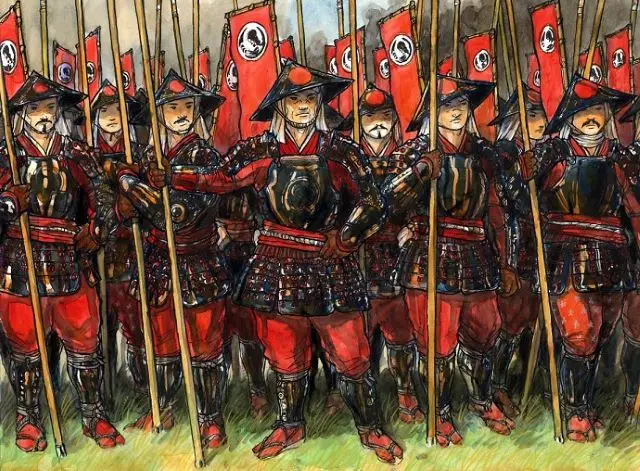
Over time, yari supplanted even traditional long bows (yumi) and became the main weapon of samurai. The Ashigaru, following the example of the military elite, also made extensive use of pikes. However, with the advent of the Edo period, the situation changed. The Age of Peace reduced the need for mass warfare, and attention focused on close combat. Swords regained their importance, while ancient weapons and archery gradually lost their martial significance.
During the Edo period, yari were still made, sometimes even by famous blacksmiths, but their use became ceremonial or limited to the function of police weapons.
Design and use
The average length of a traditional Japanese yari spear was between 2 and 3 meters, and the blade itself could be up to 50 cm long. There were many variants and modifications: katakama-yari, jumonji-yari, magari-yari, tsukinari-yari, kagi-yari, sankaku-yari, fukuro-yari and others. These weapons were widely used by both samurai and ashigaru (infantry).
Early forms of Japanese spears were called hoko and had diamond-shaped tips about 25 centimeters long. Sometimes a hook curved downward was added. There was also the so-called teboko, a “hand spear” with a long blade and a short hilt. This weapon was versatile in close combat: it could stab and stab from above or below.
By the Kamakura period (XII-XIII centuries), the spear had acquired a standard length and became the only Japanese weapon with a double-sided sharpening. Since that time, it has been known as the yari.
The standard length of a yari ranged from 180 to 240 cm, of which 15-90 cm was the blade. Unlike the naginata, the shaft of the yari was circular in cross-section, while the blade was of uniform width and had a dagger-like point. Some spears, used mainly by samurai servants, had a single-edged blade (e.g., kikuchi-yari) or an elongated triangle-shaped blade (te-yari).
The su-yari (or so-yari) was characterized by an elongated, almost sword-shaped blade and was popular in the 15th century. A more complex variant is the katakama-yari, equipped with a massive upward curved hook. This weapon was often used by high-ranking samurai.
There was also the kama-yari, a spear with a downward curved hook. It was used less frequently and was found in the arsenals of some ninja schools, where it was used as a bagor or sickle. Some kama-yari had a double hook. Another type was the magari-yari, with two side teeth that resembled a trident. A more versatile weapon was considered to be the jumonji-yari, a spear with a cross-shaped blade sharpened along its entire length. The blade could be either symmetrical or slightly curved.
There were also spears with blades shaped like the letters “L” or “T”, with numerous spikes, and with a broad blade resembling the ancient Korean sekiro, which allowed to stab, chop, and claw the enemy. For bear hunting, the kuda-yari was used, a spear with a movable protective tube through which the spear could be slid forward and backward, keeping one hand safe. The shiai-yari, a spear with a soft leather tip, was used for training.
In addition to the classic yari, there were also long spears (over 3 meters), usually simple bamboo stakes (take-yari), which were used by peasants to finish off the wounded on the battlefield. Darts (nage-yari) and short spears (uti-nae, with a shaft length of about 30 centimeters) were also known. Their tips had 3-4 points and were used not for throwing, but for close combat and technical techniques (diversions, hooks, etc.).
In Japan there was even a telescopic spear similar to the Chinese one: its shaft consisted of metal or bamboo sections nested in each other. When folded, it could fit in the hand, but when necessary it could be extended to a standard length - convenient in limited spaces.
The main types of Japanese spears by the shape of the tip
Sankaku-yari - “triangular spear”
A spear with a narrow, triangular in cross-section spike without cutting edges. It is designed to pierce armor, including metal armor, which was poorly handled by ordinary yari. There are two subtypes: Sei-sankaku-yari - triangular tip with equal sides (equilateral triangle). Hira-sankaku-yari-a triangular section with two equal sides (isosceles triangle).
Ryo-shinogi-yari
A spear with a tetrahedral blade. More durable and resistant to damage.
Fukuro-yari - “socket spear”
Blade and socket are forged from a single piece of metal. The tip is attached to the shaft (ebu) through a hollow sleeve rather than through the shank-nakago.

Kikuchi-yari
A rare spear design with a single stiffening rib. Reminiscent of a hacking tool. The only yari to use a habaki (stop at the base of the blade).

Yajiri-nari yari - “shovel-shaped spear”
A spear with a broad, shovel-shaped tip. It provides powerful stabbing and slashing blows.
Jumonji-yari - “cross-shaped spear”
Also known as magari-yari - has a central straight blade and two upward curved side blades. All parts are usually sharpened on both sides. A special variant is the te-tigai-jumonji-yari, which has a center blade turned 90° to the side blades. Such spears were considered to have magical powers and eventually became ceremonial, adorning official daimyo processions.

Kama-yari - “sickle-shaped spear”
A spear with a central blade and one or two side blades resembling a peasant sickle (kama). It was often used as a multifunctional combat tool.
Katakama-yari - “one-sided sickle”
A variation of the jumonji-yari with a single side blade. Legend has it that Kato Kiyomasa, a samurai and tiger hunter, first used this weapon after losing one side blade while hunting. Sometimes the side blades point downwards - such spears are designated by the prefix shitamuko, for example: shitamuko-kama-yari.

Tsuki-nari-yari - “crescent-shaped spear”
Had a crescent-shaped blade. It differed from traditional spears by its unusual appearance.
Kagi-yari - “hook spear”
A spear with a side hook. It was used to seize an enemy's weapon or to pull a rider off a horse.
Bisyamon-yari
One of the most elaborate and decorative spears. It has two lateral sickles attached parallel to the central blade, creating a shape resembling a fleur-de-lis (heraldic lily).
Hoko-yari
The oldest type of spear, known since the Nara period (710-794). It had a leaf-shaped or wavy blade, sometimes with sickle-shaped horns at the base. It was used by guards and as a guard weapon.
Sasaho-yari - “bamboo leaf-shaped spear”
Had a broad, leaf-shaped blade. One of the most recognizable types of spearhead.
Su-yari - “straight spear”
A simple and common type of yari with a straight, double-sided blade. It was the most widely used.

Sasumata-yari / Futomata-yari
A spear with a split tip in a U or Y shape. Used by police and firemen in the Edo period to disarm criminals, including those armed with swords. Effective against both foot and mounted enemies.
Omi-no-yari - “elongated spear”
An elongated version of the su-yari, with a longer and heavier tip. It was used in battle formations to break through enemy defenses.

Main types by shape and length of the shaft
Nagae-yari - “long spear”
Length: from 5 to 6 meters (16.4-19.7 feet). Used as a spear, mainly by infantry (ashigaru) for formations and defense against cavalry.
Moti-yari - “spear for holding in the hand”
A medium-length spear designed for use by both ashigaru and samurai in close combat.
Kuda-yari “tubular spear”
Has a hollow metal tube through which the shaft passes. It allows the tip to rotate and move back and forth. Characteristic of the Owari Kan-ryu school, one of the traditional schools of spear art (sojutsu).
Makura-yari - “pillow spear”
A compact spear with a short shaft. Held at the headboard or bedside in the home for self-defense and nighttime protection.
Te-yari - “hand spear”
A yari with a shortened shaft. It was used by samurai police to capture and disarm criminals without inflicting fatal wounds.
Take-yari - “bamboo spear”
A simple spear made of bamboo. It was used mainly in the militia or as an improvised weapon.
See also
-
Sojutsu - The Art of the Spear
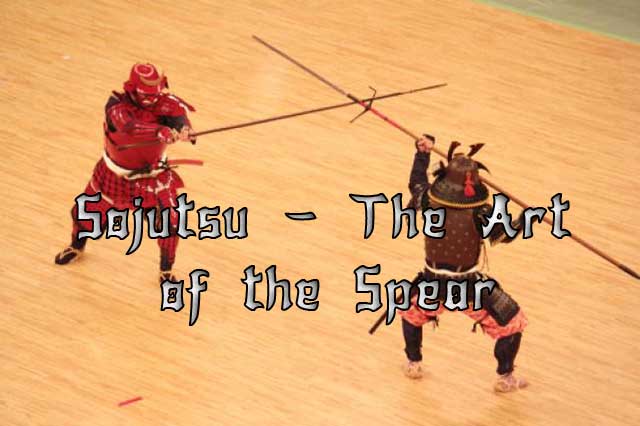
Sojutsu is a traditional Japanese martial art dedicated to the mastery of the yari spear. It is considered the second most important martial art of medieval Japan after swordsmanship.
-
Wakizashi and tanto

In the history of Japanese edged weapons there are objects that border between the concepts of “sword” and “knife”. This is especially true of the wakizashi, a short sword traditionally carried by samurai along with the katana, and the tanto, a combat knife popular among a wide range of social classes. Both items were worn behind the belt, had a short blade, and were used in close combat. However, there is a fundamental difference between the two, and it goes far beyond simple blade length.
-
Katana and Tachi
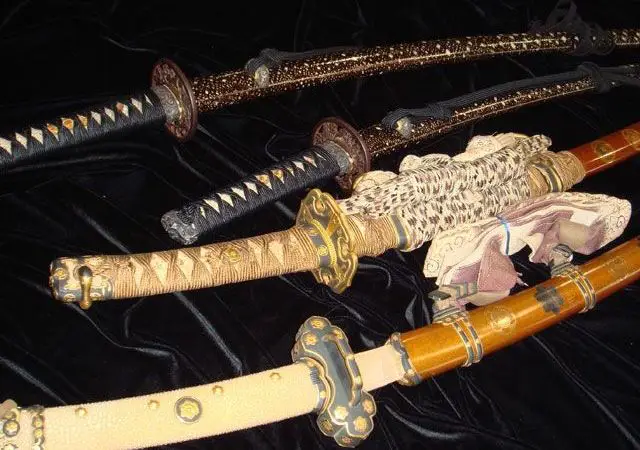
When Westerners think of Japanese swords, they often picture the iconic curved blades like the katana. However, in terms of historical precedence and prestige, it would be more accurate to reverse this image—the tachi predates the katana and traditionally held a higher status.
-
Daisho: The Origins and Evolution of the Samurai Sword Pair
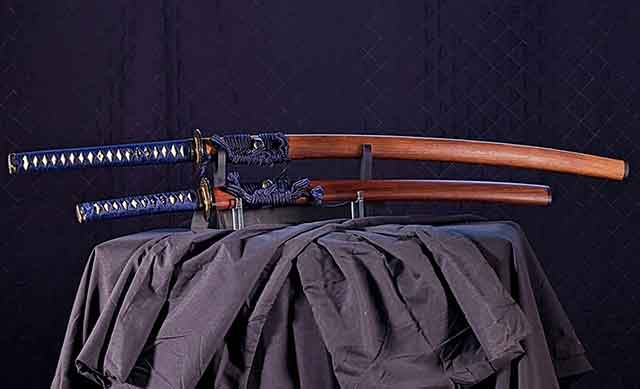
The term "daisho" finds its roots in the combination of two Japanese words: "daito," denoting a long sword, and "shoto," signifying a short sword. The combination of the words daito and shoto made the word. Daisho referred to the practice of wearing both a long and short katana together, regardless of their matching characteristics. While the classic depiction of daisho involves a katana and wakizashi (or tanto) in matching koshirae, any pairing of a longer sword with a tanto can also be considered a daisho. It later came to mean two swords with coordinated fittings. While having blades from the same swordsmith was an option, it was not a requirement for a pair to be classified as a daisho, as this would have been a more costly choice for a samurai.
-
Tanto
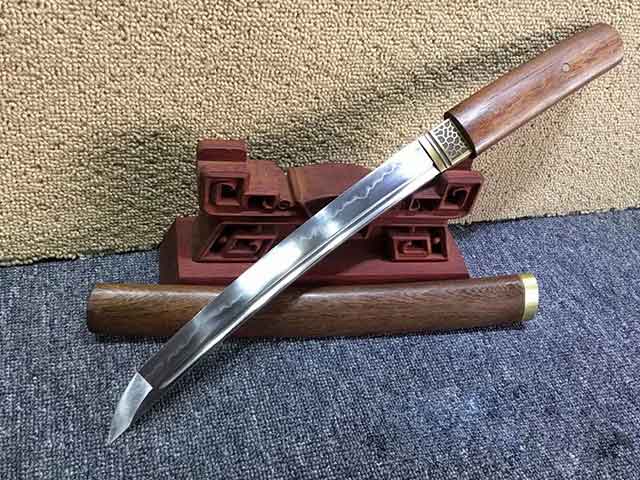
The Tanto knife is a traditional Japanese dagger that was once an integral part of the samurai warrior’s arsenal. It is known for its unique shape and cutting ability, and it is still revered by many martial artists and knife enthusiasts today.
-
Tachi
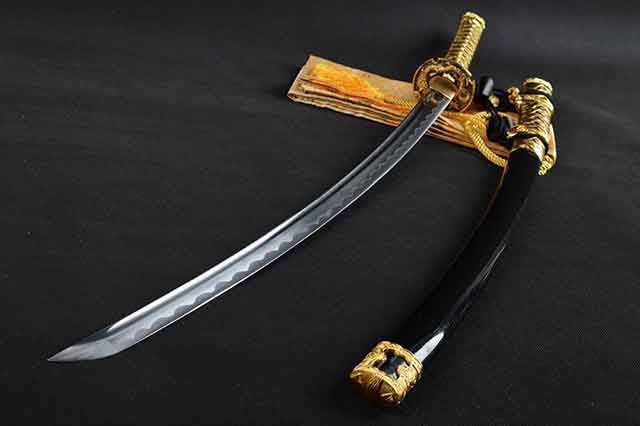
The samurai sword known as Tachi is one of the most iconic weapons in Japanese history. Its unique design and construction made it a popular choice among samurai warriors, and it played a significant role in many battles throughout Japan's history.
-
Nagitana
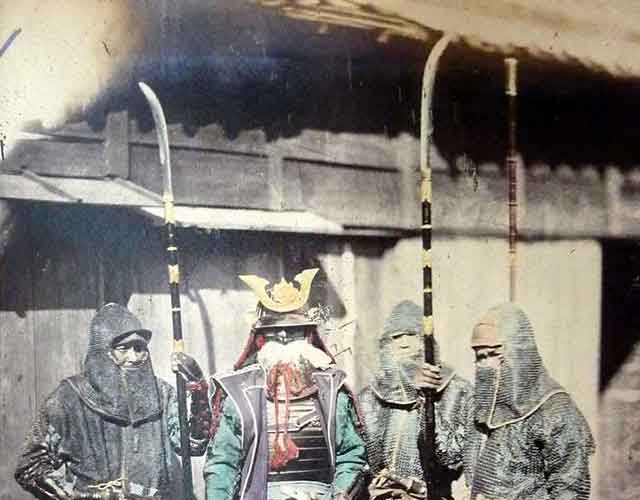
The Nagitana is a formidable weapon that was used by the samurai during feudal Japan. It was a polearm that combined the elements of a spear and a sword, making it a versatile weapon that was effective both at long range and in close combat. In this article, we will explore the history, construction, characteristics, and usage of the Nagitana.
-
Wakizashi
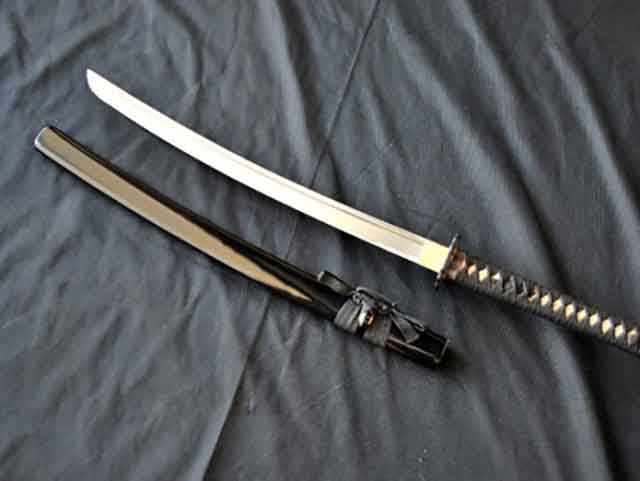
How did Wakizashi come about
The wakizashi, also known as the companion sword, is a traditional Japanese short sword that was widely used by the samurai warriors during the feudal era in Japan. This versatile sword has a long and rich history, and has played an important role in Japanese culture and warfare for centuries.

